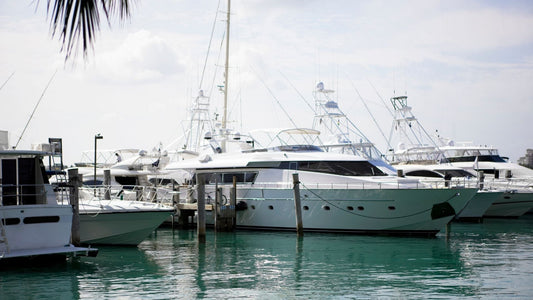
What is a Keel on a Boat?
Nicholas HeislerShare
The keel is one of the most fundamental parts of a boat's design, playing a critical role in its stability, balance, and handling on the water. It is often referred to as the "backbone" of a boat, running along the bottom of the hull and extending along its length. In this blog, we'll dive into what exactly a keel is, why it's important, and how different types of keels serve various purposes.
Table of Contents:
- Definition of a Keel
- Functions of a Keel
- Types of Keels on a Boat
- Materials Used in Keels
- Why the Keel is Crucial for Sailboats
- Keel vs. Hull: What's the Difference?
- Importance of Keel Maintenance
Definition of a Keel
In simple terms, the keel is a structural component that runs longitudinally along the bottom of the boat's hull. Its primary purpose is to provide balance and stability to the vessel. The keel helps prevent a boat from tipping over or swaying excessively, especially in windy conditions or rough waters. Additionally, the keel enhances the boat's hydrodynamics by helping it cut through the water more efficiently.
On sailboats, keels are especially important for counteracting the lateral force of the wind. Without a keel, a sailboat would drift sideways instead of moving forward.
Functions of a Keel
- Stability and Balance: The keel's weight and shape are designed to lower the boat's center of gravity, making it harder to tip over. This is particularly important in sailboats, where the forces from wind and waves can be significant.
- Directional Control: By acting like a fin in the water, the keel helps prevent the boat from sliding sideways, a process known as "leeway." It enables the boat to maintain its course, especially when under sail.
- Structural Strength: The keel supports the hull of the boat, providing reinforcement that can absorb impacts from waves or grounding.
- Improved Sailing Performance: For sailboats, the keel is essential for harnessing the power of the wind. It helps to balance the sail's forces, ensuring that the boat moves forward rather than being pushed sideways.
Types of Keels on a Boat
Boats have a variety of keel designs, each with different benefits based on the type of vessel and its intended use.
- Full Keel: Running almost the entire length of the boat's bottom, a full keel offers excellent stability and is common in traditional sailing yachts. Full keels are preferred for long-distance cruising due to their durability and ability to keep the boat steady.
- Fin Keel: This type of keel is shorter and deeper, offering less drag and greater maneuverability. It is typically used in modern racing yachts and performance sailboats, as it allows for faster speeds.
- Wing Keel: Invented by Australian yacht designer Ben Lexcen, this keel has horizontal "wings" at its base. The wing keel improves lift, allowing the boat to sail efficiently without as much depth. This design became famous during the 1983 America's Cup when it helped Australia II secure victory.
- Bulb Keel: This type of keel has a heavy "bulb" at the bottom that adds significant weight. It provides a lower center of gravity and is ideal for racing sailboats that want to maximize speed without sacrificing too much stability.
- Swing or Lifting Keel: These keels can be adjusted or retracted, allowing boats to navigate shallow waters. When in deeper waters, the keel can be lowered to provide stability. This design is common in trailerable boats and smaller sailboats.
Materials Used in Keels
Traditionally, keels were made of wood, often the same material as the hull. However, modern keels are usually made of:
- Lead: Extremely dense, lead keels provide stability without taking up much space. Lead is common in performance boats.
- Iron: Although heavier than lead, iron is more affordable and still offers excellent balance and stability.
- Ballasted Keels: These keels have internal compartments filled with materials like lead or concrete, which adds weight and stability while keeping the keel relatively compact.
Why the Keel is Crucial for Sailboats
While all types of boats can have a keel, it is especially crucial for sailboats. In sailing, a boat's forward motion comes from the wind pushing against its sails, but this force doesn't always act in the ideal direction. The keel counteracts the sideways push from the wind, allowing the boat to move forward.
Sailors rely on keels not only for stability but also for preventing capsizing in strong winds. In this way, the keel serves as an essential safety feature.
Keel vs. Hull: What's the Difference?
It's easy to confuse the keel with the hull, as both are located on the bottom of the boat. However, they serve different functions. The hull is the main body of the boat, while the keel is a structural fin or protrusion that provides balance and stability.
Importance of Keel Maintenance
The keel is a robust part of the boat, but it still requires proper care and maintenance. Saltwater, collisions, and long-term wear can damage the keel, potentially affecting the boat's handling. Regularly inspect the keel for damage, particularly if it's made of metal, which can rust or corrode. Use a boat cleaner periodically to keep your keel clean and free of barnacles or grime.
Conclusion
The keel is a vital component of any boat, especially sailboats, providing stability, balance, and improved handling. There are many types of keels, each designed for specific uses, from racing to long-distance cruising. Whether you own a modern yacht or a classic sailboat, the right keel design will make your time on the water safer and more enjoyable.
When it comes to keeping your boat's keel clean, look to Captains Preferred Products boat brushes and cleaning supplies. Find everything you need to keep your vessel squeaky clean all season - always at the best prices.




